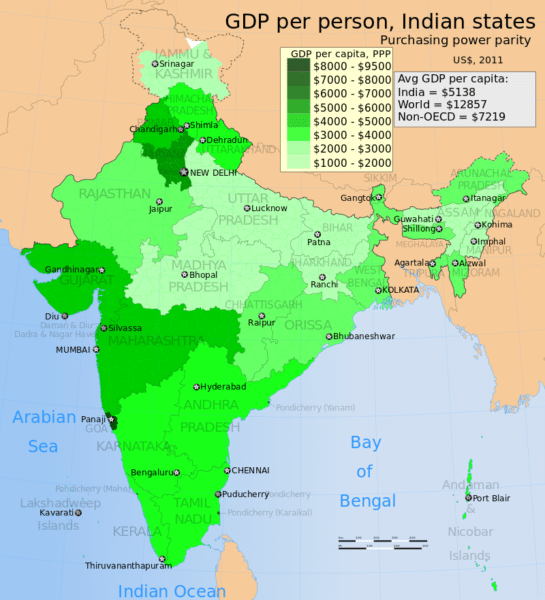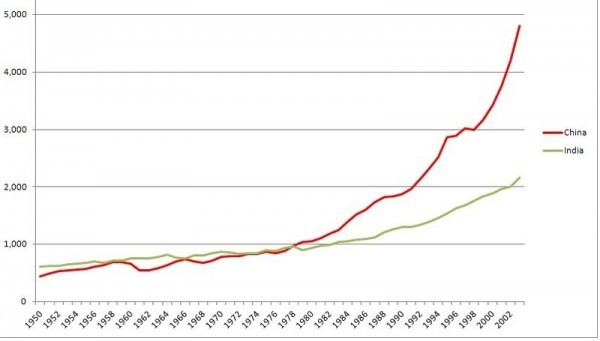Since 1991, the Indian economy has pursued free market liberalisation, greater openness in trade and increase investment in infrastructure. This helped the Indian economy to achieve a rapid rate of economic growth and economic development. However, the economy still faces various problems and challenges, such as corruption, lack of infrastructure, poverty in rural areas and poor tax collection rates.
GDP per capita (in 1990 Geary-Khamis dollars) (data range 1950-2003)
1. Unemployment
Despite rapid economic growth, unemployment is still an issue in both rural and urban areas. The fast rate of economic growth has left unskilled workers behind, and they have struggled to find work in growing industries. In 2017, the official unemployment rate was just below 5%. However, a report by the OECD found over 30% of people aged 15-29 in India are not in employment, education or training (NEETs). Livemint reported on March 6, 2017. WIth, little if any government welfare support for the unemployed, it leads to dire poverty.
2. Poor educational standards
Although India has benefited from a high % of English speakers, (important for call centre industry) there is still high levels of illiteracy amongst the population. It is worse in rural areas and amongst women. Over 50% of Indian women are illiterate. This limits economic development and a more skilled workforce.
3. Poor Infrastructure
Many Indians lack basic amenities lack access to running water. Indian public services are creaking under the strain of bureaucracy and inefficiency. Over 40% of Indian fruit rots before it reaches the market; this is one example of the supply constraints and inefficiency’s facing the Indian economy.
4. Balance of Payments deterioration.
Although India has built up large amounts of foreign currency reserves, the high rates of economic growth have been at the cost of a persistent current account deficit. In late 2012, the current account reached a peak of 6% of GDP. Since then there has been an improvement in the current account. But, the Indian economy has seen imports growth faster than exports. This means India needs to attract capital flows to finance the deficit. Also, the large deficit caused the depreciation in the Rupee between 2012 and 2014. Whilst the deficit remains, there is always the fear of a further devaluation in the Rupee. There is a need to rebalance the economy and improve the competitiveness of exports.
5. High levels of private debt
Buoyed by a property boom the amount of lending in India has grown by 30% in the past year. However, there are concerns about the risk of such loans. If they are dependent on rising property prices it could be problematic. Furthermore, if inflation increases further it may force the RBI to increase interest rates. If interest rates rise substantially it will leave those indebted facing rising interest payments and potentially reducing consumer spending in the future
6. Inequality has risen rather than decreased.
It is hoped that economic growth would help drag the Indian poor above the poverty line. However, so far economic growth has been highly uneven benefiting the skilled and wealthy disproportionately. Many of India’s rural poor are yet to receive any tangible benefit from the India’s economic growth. More than 78 million homes do not have electricity. 33% (268million) of the population live on less than $1 per day. Furthermore with the spread of television in Indian villages the poor are increasingly aware of the disparity between rich and poor. (3)
7. Large Budget Deficit
India has one of the largest budget deficits in the developing world. Excluding subsidies, it amounts to nearly 8% of GDP. Although it is fallen a little in the past year. It still allows little scope for increasing investment in public services like health and education.
8. Rigid labour Laws
As an example Firms employing more than 100 people cannot fire workers without government permission. The effect of this is to discourage firms from expanding to over 100 people. It also discourages foreign investment. Trades Unions have an important political power base and governments often shy away from tackling potentially politically sensitive labour laws.
9. Inefficient agriculture
Agriculture produces 17.4% of economic output but, over 51% of the work force are employed in agriculture. This is the most inefficient sector of the economy and reform has proved slow.
10. Poor tax collection rates.
According to the Economist, India has one of the poorest tax to GDP rates in the whole world. India’s tax revenue as a % of GDP is just 12%. Compared to an EU average of 45%. This poor tax collection rate reflects widespread corruption, tax avoidance and complicated tax rates. In 2017, Narendra Modi has sought to improve tax collection rates and reduce complications through the introduction of a general sales tax (GST) which involves a single tax rate – rather than tax rates applied multiple times at different stages of production. (Modi’s tax gamble at Economist)
11. Business difficulties
According to the World Bank, the ease of doing business in India is poor. India ranks 130/190. Big issues for companies include
- Ease of enforcing contracts
- Dealing with construction contracts
- Paying taxes
- Trading across border
12. Inequality within regions
India’s economic growth has benefitted some regions more than others. Technological hubs, such as Delhi and Mumbai have attracted higher paying jobs. This has attracted an inflow of most mobile and skilled workers; this has created congestion in these super-cities but failed to address the poverty of rural areas, especially in the north east


